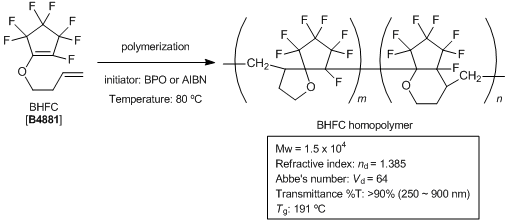Published TCIMAIL newest issue No.197 | New tool "TCI SpectraViewer" | [TCIPracticalExample] Three-component Reaction Using... | Product Document Searching Made Easy by 2D Code!
Maximum quantity allowed is 999
Please select the quantity
Cyclic Olefin Monomer for Transparent Fluorinated Polymers
Fluorinated polymers as typified by polytetrafluoroethylene (PTFE) are used for high chemically-stable materials which exhibit heat resistance, chemical resistance and flame resistance. Moreover, polyfluorinated polymers show a low refractive index and low wavelength dependency of the refractive index because of the small polarizability of carbon-fluorine bonds. So they are applied to optical fibers and antireflection coating materials of flat-panel displays.
1-(3-Butenyloxy)-2,3,3,4,4,5,5-heptafluorocyclopentene (BHFC), developed by Kubota et al. is a polyfluorinated cyclic monomer, which forms the spiro- and bicyclo-structured homopolymer by bulk polymerization with an initiator like benzoyl peroxide (BPO) or 2,2-azodiisobutyronitrile (AIBN). It has been reported that the homopolymer dissolves in organic solvents and shows high light transmissibility, low refractive index and high glass-transition temperature.
1-(3-Butenyloxy)-2,3,3,4,4,5,5-heptafluorocyclopentene (BHFC), developed by Kubota et al. is a polyfluorinated cyclic monomer, which forms the spiro- and bicyclo-structured homopolymer by bulk polymerization with an initiator like benzoyl peroxide (BPO) or 2,2-azodiisobutyronitrile (AIBN). It has been reported that the homopolymer dissolves in organic solvents and shows high light transmissibility, low refractive index and high glass-transition temperature.

Related Products
References
- Recent Development of Fluorine-containing Transparent Polymers
- Transparent Polymers Containing Partially Fluorinated Spiro-Structure in Their Main Chains
- T. Kubota, A. Takagi, Ibaraki University, JP Patent 4399608.

